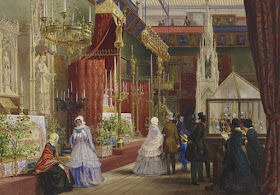 |
| Great Exhibition - watercolour painting by LOUIS HAGHE (1806-85), by the time photography is still under development. - Photo by: royalcollection.org.uk |
It’s taking a while for me to work on my London
visit’s articles and delay many other posts (for V&A and British Museum).
Anyway, before I post the next article about Victoria & Albert Museum, I
would like to come out with this article first - the watercolour paintings.
Many thoughts that watercolour painting not as
good or as pricey as many other paintings especially oils or acrylic paintings.
Not to mention about the watercolour techniques that highlighted, mostly
showing that watercolour paintings unable to produce photo realistic effect
(instead just an illusion of the subjects). In fact, watercolour paintings has
been used to record many discoveries/events since long time ago, and I think
it’s time again to bring back the watercolour painting to its glory.
Watercolour whether on its own, or use together
with other media can really come out with better results. In some cases mixed
media were chosen for a few reasons; to speed up the process, to bring out
certain effect that cannot be achieved by using only watercolours. There’s no
wrong in using the mixed media as long as it’s not ruining the result – or the
painting still can last longer for future storage.
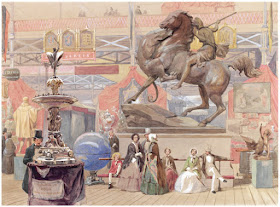 |
| Great Exhibition – watercolour and gouache over pencil on paper, John Absolon (1815-95). – Photo by: vam.ac.uk |
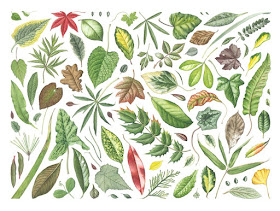 |
| Botanical painting helps the identification of plant species, and also beautiful. Painted by Julia Trickey - Photo by: doodlewash.com |
By using the right watercolour techniques, it’s
still possible to show every detail in watercolour painting, especially on how
important it is in recording information. Here we will see some samples of
watercolour paintings that used to record botanical species of plants and also
a painting to record an important event.
Types of watercolour paintings.
Watercolour has various techniques that allow
it to produce different results. However, before we get more details on the
watercolour techniques, we also need to know there are many types of
watercolours. There are few types of watercolour itself (from student grades to
artist grades). Other than that, beginner also might get confuse watercolour
with gouache and also poster colour. One thing to remember is that watercolour
has transparent quality that make it different from any other colouring media.
The good quality watercolour has better
transparency and the same time have brighter colour from the colour pigments.
Some artist grade watercolour can be very costly - so take your time to
practice to make sure before investing on higher price watercolour.
These are some popular watercolour techniques
to learn;
- The wash
- Wet on wet
- Wet on dry
- Dry brush
- Glazing
- Lifting off
- Pigment saturation, pigment desaturation
- Gloss
- Mixed media
* Check this link for more
watercolour techniques.
You will keep listening these techniques being
mentioned when you learn the watercolour techniques through video tutorials. It’s
easy to understand, but you need to try it by yourself to master the
techniques. Usually one or few of the techniques used together to produce on
paintings. We will see that in the next section.
Learn to use watercolour.
As many people think that watercolour is one of
the hardest media to use for paintings, so we need to have proper training in
mastering the watercolour techniques. Luckily, with the availability of
YouTube, many watercolour artists share their techniques through video
tutorials that make it easier for us to learn. So here, I will share few
watercolour artists that I found through YouTube where we can learn so many things
from them.
Before we go any further, all we need to
remember is, there’s no limitation on the techniques that we should use with
watercolour. So we need to explore as much as we can to know which one is
suitable with our drawing styles.
Anna Mason
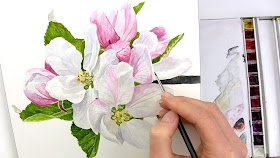 |
| Anna Mason’s painting of apple blossom. Photo by: Anna Mason |
Anna Mason from AnnaMasonArt is
one of the best examples of watercolour painter. She wonderfully transforms
watercolour painting back to how it was used to be. Anna, successfully
producing photorealistic paintings with watercolour. Even though mostly
focusing on nature, her paintings are so beautiful and lively – make her
customers very proud to have her paintings (prints and the originals).
The best thing about Anna is, she also provided
free video tutorials through her website; annamasonart.com, and it’s available
to everyone. With Anna’s techniques, it is suitable if you like to paint the
nature subjects. This is very important for natural and history paintings.
Mateusz Urbanowicz
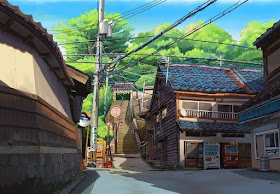 |
| Anime style watercolour painting by Mateusz Urbanowicz. - Photo by: Mateusz Urbanowicz |
Mateusz is a comic painter located in Japan. He
uses lots of watercolours in his paintings. Influenced by Studio Ghibli’s
styles of paintings, Mateusz also paints backgrounds for animations, books and
magazines. With his styles, we learn different techniques that using
watercolours, mixed with black ink pen. You can watch most of his videos from
his channel MateuszUrbanowicz on YouTube.
This type of paintings suitable if you want to
produce comic style paintings, but it’s still nice for landscape and
informational brochures. Mateusz also produced a book that illustrated of
storefronts in Tokyo with his techniques – that’s I find amazing.
Laovaan
 |
| Digital anime styles using watercolour by Laovaan. - Photo by: Laovaan |
Laovaan is a stylist watercolour painter. He
uses mixed media with contemporary subjects. You will see his painting with
bright colours because he used ink watercolours mixed, and sometimes also
colour pencils and marker pens. He is popular with his digital style
watercolour paintings with manga character styles – this is so popular with
manga lovers. You can follow his videos through YouTube channel; Laovaan. He
also has his own patreon channel if you want to follow his styles seriously.
Stan Miller
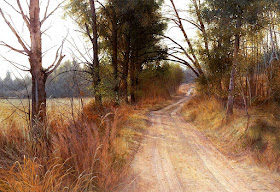 |
| Landscape by Stan Miller using egg tempera technique. – Photo by: Stan Miller |
Stan Miller is one of the popular painters in
watercolour and egg tempera medium. Instead of just doing a painting he also
conducted classes throughout US and sometimes overseas. His art not focusing on
to be photo-realistic, but truly amazing to watch. To know more about his
techniques you can visit his YouTube channel; Stan Miller,
visit his website; stanmiller.net or search
his name on the YouTube – because there are videos about his work on different
channels too.
There are many other amazing watercolour
painters out there where we can learn. Learning from different painters will
allow us to explore as many possibilities as we can, to come out with styles
that suits us. Even though we want to create the best art with our works, don’t
forget the most important elements doing it - enjoy it! Sharing your works and
your thoughts on the comment section below or send it to my email using the
contact form (available on web version view).








































